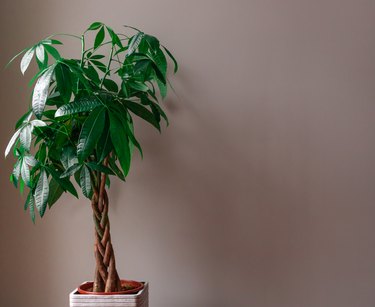
No, you can't pick its leaves and take them to the bank, but the money tree (Pachira aquatica, USDA plant hardiness zones 10 to 12) has many endearing qualities. They are also called water chestnuts, Malabar chestnuts, braided money trees or Guiana chestnuts, and they can be grown successfully indoors or outdoors. It can be a large shrub or an evergreen tree and features large, yellowish-white or green flowers with red stamens and edible fruit. Like other plants, though, money trees can succumb to diseases. You may be unpleasantly surprised one day to find brown and white spots on your money tree.
White Spots on Money Tree Leaves
Video of the Day
Money Trees are not hard to care for as long as they are in the right location and get the proper amount of water. One of the diseases to which they are most susceptible is Anthracnose leaf spot, which causes white spots on money tree leaves. This is actually a fungal disease that usually appears in the early spring. As time passes, the spots get bigger and turn into blotches, killing the leaves. Fungicidal sprays can eliminate the problem if used according to the label's directions.
Video of the Day
To prevent this leaf spot disease, the foliage should be kept dry, and the tree must be watered thoroughly but not too often. Rainwater is best, and money trees prefer slightly wet to dry soil. This money tree fungus can also be prevented by keeping the area free of debris, watering the tree thoroughly and infrequently and keeping its foliage dry. Fungicidal sprays are effective in controlling the disease.
Other Money Tree Diseases
Money trees can also get powdery mildew, which starts on leaves that have fallen off; the spores then latch onto the tree. This also causes white spots, but they are smaller ones that then form the powdery coating on the leaves. Other symptoms include foliage wilting and leaf curl. This can be cured with a fungicidal soap. Mix it with warm water and wipe down the leaves. Also, be sure to remove any infected areas and keep the surrounding soil clear of any debris.
Too much watering can lead to mold or root rot. The mold can appear on the ground first and may look whitish-gray. This can often be fixed by simply removing the affected soil. Root rot occurs when money plants get too much moisture and leads to soft stems and dropped leaves. When that happens, the plant may need to be pulled up, have its root ball cleaned of the rotten pieces and then be replanted or repotted.
Different Types of Money Plants
Although there is one main type of money tree, many different kinds of small plants are called money plants. People believe that these plants bring good luck and prosperity, and many have seed pods or leaves that resemble coins. Most also have more than one name.
The jade plant (Crassula ovata, zones 10 and 11) is a deep-green succulent that may or may not produce whitish pink flowers once a year. The familiar Chinese money plant (Pilea peperomioides, zone 10) has round, flat leaves that look like coins. It is also called a UFO plant, mirror grass or a pancake plant. Pennywort (Hydrocotyle vulgaris, zones 5 to 9) is also called a lucky plant, copper coin plant or water navel. It smells like carrots and is actually edible, with round, bright-green leaves that look like coins.